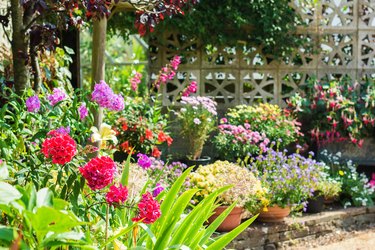
One of the great pleasures of planning a flower garden can involve attracting bees; in fact, a "pollinator garden" is frequently touted as a goal. But some people are allergic to bees, and if you have children playing in your yard, the last thing you want is a cloud of bees exactly where young hands might be plucking that enticing flower.
If this is you, you can plan a flower garden that incorporates plants that repel bees. The way to do this is to choose bee-repellent flowers rather than trying to control them using insecticides or chemicals — because you absolutely don't want to harm beneficial pollinators like bees.
Video of the Day
Video of the Day
Discover which flowers are bee repellent — and why bees prefer certain flowers over others.
Why Are Some Flowers Bee-Repellent?
While there are some specific flowers that bees appear to dislike, recent studies have also shown that in general, bees avoid flowers that have double petals or a complex petal formation, such as popular hybrids that have been "improved" with more spectacular blooms.
Dave Goulson, professor of biology at the University of Sussex School of Life Sciences, tells Hunker, "Our tinkering with flowers to create bigger, showier blooms has often resulted in flowers of little interest to bees. Many of these flowers either don't produce much nectar and pollen, or bees can't access them because their flower petal arrangements are so complex."
So, if you're determined to keep bees away from certain areas (like the front door or the area by the swing set), the following are the best flowers to plant, according to Goulson.
1. Begonias
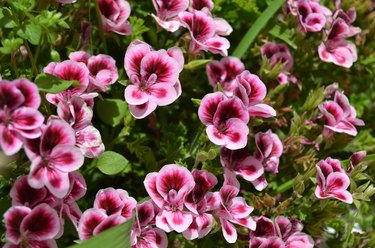
Begonias (Begonia spp., USDA plant hardiness zones 6 to 11 depending on species) are a colorful addition to any garden and are available in an amazing array of both leaf and flower colors, but they produce almost no pollen. Among the most popular begonias is the Begonia (Tuberosa group), a group of hybrids grown from tubers.
Quick Care Tips:
Begonias are warmth-loving plants that generally prefer partial shade. Never let these beauties dry out.
2. Impatiens Busy Lizzy
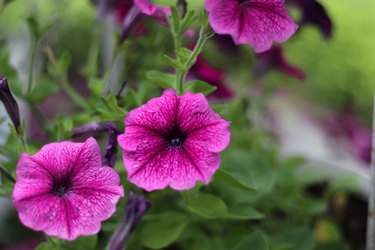
Busy Lizzy (Impatiens walleriana, USDA zones 10 to 11), is an impatiens that tends to have little nectar and pollen. Even those impatiens that produce negligible amounts of these nutrients typically attract butterflies rather than bees.
Quick Care Tips:
This plant loves plenty of water and requires partial shade if not full shade, as it can quickly wilt and has a low drought tolerance. Regular watering during hot, dry spells is critical.
3. Petunia
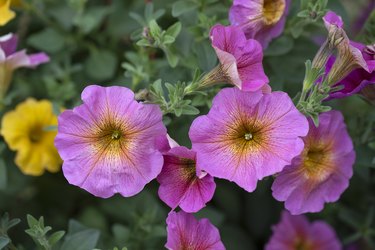
Petunias (Petunia x hybrida, USDA zones 10 to 11) are ubiquitous in summer gardens, overflowing hanging baskets with their cheerful blooms. Hybrid petunias have been bred to produce little or no nectar, so they are of little interest to bees.
Quick Care Tips:
Petunias are famously sun-loving, although they can handle partial shade, with moderate drought tolerance. To grow petunias, you can plant them in beds, containers, or borders for a continual display of color throughout the summer season.
4. Pansies

The common garden pansy (Viola x wittrockiana, USDA zones 6 to 10) graces the late winter and early spring garden with cold-tolerant blooms. While they are perennials, pansies are short-lived and are usually grown as annuals. Pansies have been bred so that they have little pollen or nectar, and they also have long nectar tubes, making it difficult for many pollinators to reach. Even long-tongued bees and small bees that can work themselves down to the nectar find little reward in the sparse nectar, and they move on to easier and more profuse nectar sources in other flowers.
Quick Care Tips:
Pansies can grow in either full sun or partial shade. Plant them in beds, containers, or borders for a spot of color on dreary days.
5. Hybrid Tea Roses
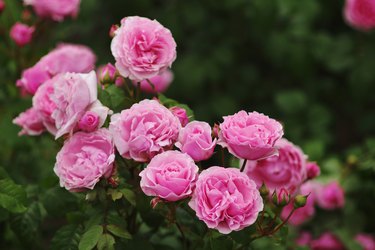
Who wouldn't want hybrid tea roses to be a focal point in a home garden? Horticulturists have been focused on developing a huge array of rose cultivars for decades, and many of these are poor pollen and nectar products, in particular hybrid tea roses (Rosa x hybrida, USDA zones 5 to 11 depending on variety) along with rugosa roses (Rosa rugosa, USDA zones 2 to 7) and the hybrids in the Knock Out group (Knock Out® Rosa x, USDA zones 4-11 depending on cultivar).
Quick Care Tips:
Plant hybrid roses in full sun and on rich soil with high organic matter and provide them with plenty of room to grow based on the cultivar.
6. Flowering Tobacco
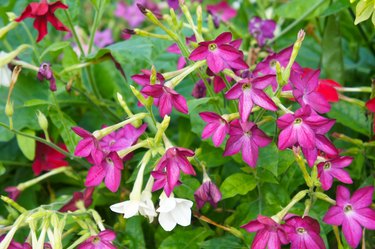
While some Nicotiana species are widely pollinated by bees, the plant commonly called flowering tobacco (Nicotiana alata, USDA zones 10 to 11) is more likely to be pollinated by moths because they are mostly night-flowering, so their nectar has a lower viscosity.
Quick Care Tips:
Flowering tobacco is a tender perennial that is usually grown as an annual. Plant it in full sun or part shade.
7. Mums
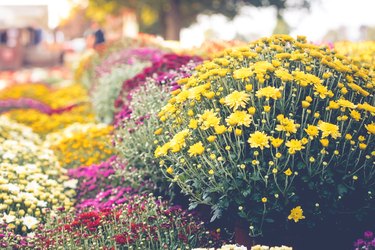
Blooming in hues of orange, pink, purple, red, white, and yellow, most mums (Chrysanthemum spp., USDA zones 3 to 9 depending on species and cultivar) lack enough pollen and nectar to attract bees in spite of their bright colors.
Quick Care Tips:
Mums require full or part sun and bloom late in the summer into the fall, helping add color to your garden when many other flower blossoms are already spent.
8. Pompon Dahlias
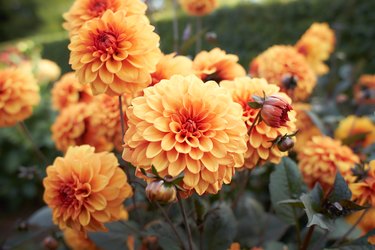
Pompon dahlias are the group of dahlia (Dahlia group, USDA zones 7 to 10 depending on variety) that produces a complex double bloom that has no visible central disc and a difficult way for pollinators to enter.
Quick Care Tips:
Like all dahlias, they prefer full sun. If you grow them outside of their growing zones, lift the tubers in the fall and replant in spring. In fact, even within a particular dahlia's zone, they may benefit from being lifted and stored over the winter.
9. Carnations
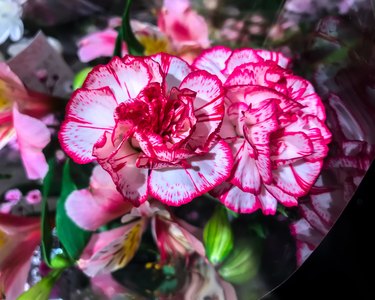
Representing one group of plants in the Dianthus genus, carnations (Dianthus spp., USDA zones 4 to 9) have lovely double flowers and have been hybridized for decades, resulting in thousands of specialty cultivars — in fact, 27,000 — just waiting for you to explore. Modern-day hybridized carnations are among the many double flowers that no longer produce pollen or nectar.
Quick Care Tips:
Plant carnations in full sun or light shade on well-draining soil.
10. Tulips and Daffodils
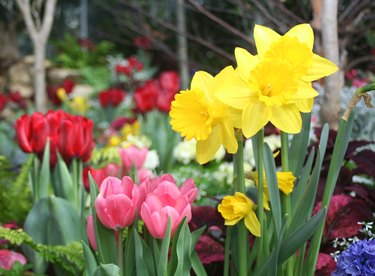
Lovely harbingers of spring, tulips (Tulipa spp., USDA zones 3 to 8) and daffodils (Narcissus, USDA zones 4 to 8) have been so highly hybridized that bees are not drawn to them. Both grow from bulbs, but daffodils dependably multiply and last from year to year, while tulips might return year after year, but they usually peter out after a few years, particularly in warm climates, and need to be replanted.
Quick Care Tips:
Both flowers like full sun and require highly fertile soils with good drainage.
11. Magnolias
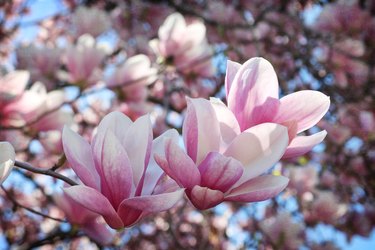
While magnolias may not attract bees, they do attract beetles, which are required to pollinate them. But if you are looking to avoid bee stings, a magnolia tree (Magnolia spp., USDA zones 3 to 11 depending on the species and cultivar), of which there are multiple species and cultivars, is a good choice.
Magnolias have famously opulent flowers, usually in colors of white, soft pink, or pale yellow. Some grow quite large, like southern magnolia (Magnolia grandiflora, USDA zones 7 to 9), which can grow 80 feet tall with a spread of 50 feet, but some are smaller specimens, like the slow-growing star magnolia (Magnolia stellata, USDA zones 4 to 8), growing to just 20 feet with a 15-foot spread.
Quick Care Tips:
Most magnolias can grow in full sun to part shade, and some can tolerate clayish soils.
12. Osteospermums
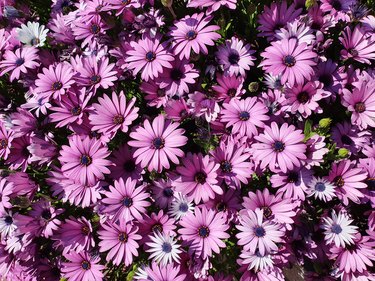
The genus Osteospermum incorporates about 70 species of annual and perennial flowers and subshrubs. These might commonly be called "African daisy," but there are really multiple varieties and cultivars under that name. All do, however, have daisylike flowers. Most osteospermum (Osteospermum group, USDA zones 10 to 11) are not of interest to bees, although some cultivars may attract them.
Quick Care Tips:
These flowers are warmth-loving plants and appreciate being planted in full sun.